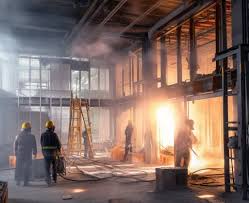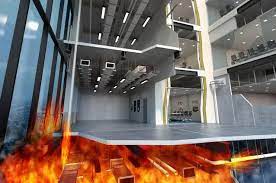How to Estimate Firestopping Costs for Your Home
Fire is one of the most unpredictable hazards a homeowner can face, and protecting your home with proper firestopping is not just about compliance, it’s about safety, peace of mind, and long-term property value. Firestopping involves sealing openings and joints in walls, floors, and ceilings to slow the spread of flames, smoke, and toxic gases during a fire.However, before starting any project, homeowners often ask: How much will it cost to firestop my home? Estimating firestopping costs can feel overwhelming because prices vary based on materials, labor, house size, and local building codes. That’s why using professional guidance such as Firestopping Estimation Services can make the process easier, more accurate, and stress-free.
This guide breaks down all the major cost factors, provides a step-by-step estimation method, and gives you practical tips to save money while ensuring your family’s safety.
Why Firestopping Matters for Home Safety
- Life Safety: Proper firestopping delays the spread of fire, giving residents more time to escape.
- Property Protection: It helps minimize fire damage, protecting valuable assets.
- Code Compliance: Many jurisdictions require firestopping to meet safety codes.
- Insurance Benefits: Fire-safe homes may qualify for better insurance rates.
Investing in firestopping is not just an expense it’s a safeguard for your loved ones and your home.
Key Factors That Influence Firestopping Costs
The cost of firestopping your home depends on several variables:
1. House Size and Layout
- Larger homes with multiple levels and open spaces will require more firestopping material and labor.
- Complex designs with numerous penetrations (pipes, wiring, HVAC) increase the overall cost.
2. Materials Used
- Firestop Sealants: Caulks and sprays, usually $2-$5 per linear foot.
- Firestop Collars and Wraps: For pipes, $10-$50 each depending on size.
- Firestop Boards and Mortars: $15-$40 per square foot, used in walls/floors with big openings.
3. Labor Costs
- Professional contractors typically charge $45-$75 per hour.
- Labor is often the biggest portion of the budget, especially if retrofitting an existing home.
4. Location and Local Codes
- Urban areas often have higher labor costs.
- Local fire codes may require specific materials that can increase costs.
5. Type of Project
- New Construction: Easier and cheaper because materials can be applied as the house is built.
- Retrofitting Older Homes: More expensive since it requires removing drywall, working around existing utilities, and resealing.
Step-by-Step Guide to Estimating Firestopping Costs
Step 1: Identify Areas That Need Firestopping
- Check walls, ceilings, and floors where utilities pass through.
- Pay attention to attics, basements, and garages common fire-prone zones.
Step 2: Measure Penetrations and Openings
- Count the number of pipes, ducts, and cable openings.
- Measure square footage for larger areas like walls or floors.
Step 3: Choose the Right Materials
- Match sealants, collars, or boards to the penetration type.
- Always select UL-rated firestop products for compliance.
Step 4: Estimate Material Costs
- Multiply the length or area by the unit price of the chosen material.
Step 5: Add Labor Costs
- Estimate contractor hours based on complexity.
- Factor in extra time for older homes or difficult layouts.
Step 6: Include Miscellaneous Expenses
- Permit fees, inspection costs, and safety equipment can add 5-10% to your total.
Typical Firestopping Cost Ranges for Homes
- Small Homes (1,500 sq. ft.) → $1,500 – $3,000
- Medium Homes (2,500 sq. ft.) → $3,000 – $6,500
- Large Homes (3,500+ sq. ft.) → $7,000 – $12,000+
Note: These numbers vary widely based on region and whether the work is new construction or retrofitting.
DIY vs Hiring a Professional
DIY Firestopping
- Suitable for very small projects like sealing a few pipes or gaps.
- Materials are available at hardware stores.
- Risks: Improper installation may fail during a fire and fail inspection.
Professional Contractor
- Trained to meet building code requirements.
- Guarantees correct product selection and installation.
- Costlier upfront but safer and code-compliant.
Regional Cost Differences
- United States: Average $3-$7 per sq. ft.
- Canada: Similar, but slightly higher in urban cities like Toronto or Vancouver.
- Europe: Higher compliance costs due to stricter codes.
- Asia: Material availability may reduce costs, but international brands are more expensive.
Tips to Save Money on Firestopping

- Plan Early: Firestopping is cheaper during construction than retrofitting.
- Combine Services: Bundle with insulation or electrical upgrades to save on labor.
- Get Multiple Quotes: Compare prices from at least 3 contractors.
- Use Professionals for Complex Work: Avoid costly code violations from poor DIY jobs.
Conclusion
Firestopping is not just another home improvement project it’s a critical safety investment. Knowing how to estimate costs helps you budget wisely while protecting your family and home from devastating fires. By understanding materials, labor, and code requirements, you can make informed decisions whether you handle small tasks yourself or hire a contractor.
And remember, when in doubt, seeking help from trusted experts through Firestopping Estimation Services ensures accurate budgeting and professional results. A little preparation today can safeguard your home for decades to come.
FAQs
1. How much does it cost to firestop a 2,000 sq. ft. home?
On average, between $3,000 and $5,000 depending on materials, labor rates, and regional differences.
2. Can I do firestopping on my own?
Yes, for minor penetrations like small pipes, but for whole-house firestopping, hiring a certified contractor is recommended.
3. Does firestopping add value to my home?
Yes. A properly firestopped home is safer, may lower insurance premiums, and increases property value.
4. How often does firestopping need maintenance?
Firestopping materials typically last many years, but inspections are recommended every 3-5 years, or after renovations.



Leave a Reply
Want to join the discussion?Feel free to contribute!